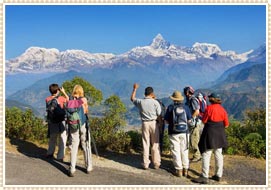Tourism sector in buoyant mood after constitution
 Kathmandu / September 23: Nepal’s tourism industry has encountered numerous devastating obstacles in the past several years. Persistent political instability has had a direct negative effect on the growth of the sector. However, the promulgation of a new constitution on Sunday has given the beleaguered industry many reasons to cheer.
Kathmandu / September 23: Nepal’s tourism industry has encountered numerous devastating obstacles in the past several years. Persistent political instability has had a direct negative effect on the growth of the sector. However, the promulgation of a new constitution on Sunday has given the beleaguered industry many reasons to cheer.
Travel trade entrepreneurs believe that the promulgation of the long-awaited constitution will end the political instability and lead the country towards economic prosperity.
Tourism is a very vulnerable industry, and strikes and bandas resulting from political unrest have dented Nepal’s image as a safe tourist destination in the international arena. But this is about to change.
“The drafting of the constitution has ended the political deadlock that has remained from a long time ago, and it will be instrumental in giving solid momentum to the country’s economy,” said Suman Pandey, president of the Pacific Asia Travel Association (Pata) Nepal Chapter. “The successful transition to a new order will help Nepal to regain its image as a tourist destination.”
Pandey said that Nepal had a lot of potential to grow. “The scope is unlimited for Nepal’s tourism, but this stability needs to create a good and economy-friendly governance system.”
Setbacks
Nepal’s tourism sector has come a long way since Edmund Hillary and Tenzing Sherpa first climbed Mt Everest in 1953. The Himalaya has been one of the main attractions for tourists visiting this country since the duo’s ascent of the highest peak in the world.
In the 1950s, there was a shortage of hotels. Beginning in the 1960s, the government encouraged the building of hotels and other tourist facilities by providing loans.
According to government statistics, the number of hotel rooms increased from under 22,000 to more than 27,000 between 1985 and 1988. Until 1983, tourism in Nepal was well established. It was a major source of foreign exchange.
Tourism was facilitated with the opening of airways to Kathmandu and other parts of the country and easing of travel restrictions. However, in 1989, a trade and transit impasse with India negatively affected tourism because the transport and service sectors of the economy lacked supplies.
Prior to the trade impasse with India beginning in March 1989, tourism had been growing by more than 10 percent per year. Between 1985 and 1988, the number of tourists increased from approximately 181,000 to about 266,000. More than 80 percent of the tourists arrived in the country by air.
However, from 1996 onwards, the country’s tourism sector faced the greatest setback. The beginning of the Maoist insurgency deterred potential tourists for a decade. Tourist numbers, particularly from India, started to drop after the December 1999 hijacking of Indian Airlines Flight 814 and the June 2001 royal massacre.
The signing of a Comprehensive Peace Accord between the government and the Unified Communist Party of Nepal (Maoist) on November 21, 2006, which formally ended the Civil War, gave a much needed boost to the industry. In 2007, arrivals jumped to a high of 526,705 tourists.
However, the culture of organizing strikes and bandas started to cripple the country after 2007 discouraging tourists from visiting Nepal. As the industry took a massive beating due to frequent strikes, the government in 2010 announced Nepal Tourism Year 2011 in a bid to boost arrivals.
At that time, 22 political parties signed a commitment letter not to organize strikes during Nepal Tourism Year. Since then, arrivals started to grow. In 2011, Nepal received 736,215 tourists; and in 2012, the figure swelled to 803,092.
Just as the tourism industry was starting to recover, the country was hit by a terrible natural disaster, the April 25 earthquake. “Despite all odds, tourism has always recovered; and we believe that the impact of the earthquake will only last for a short period,” Pandey said.
According to him, the industry has been working to disseminate positive messages to neutralize the negative talk circulating after the earthquake.
Brighter Future
After the earthquake, the tourism industry has begun to improve again. Travel trade entrepreneurs said that October bookings were looking good as international airlines had started resuming their flights and gradually increasing their frequency.
The message of political stability after the promulgation of the constitution is set to give new energy to the industry again. “Peace, safety and political stability are important determinants to attract tourists,” said Ashok Pokhrel, president of the Nepal Association of Tour Operators.
“The promulgation of the constitution will indeed be key to reviving tourism. If the constitution guarantees peace and stability, it will create a big impact on the industry in the years to come.”
(Source: www.ekantipur.com)
